In addition to dosage calculation errors (which account for roughly 7% of all reported drug errors), common errors include mistakes with drug or patient names, missed allergy alerts, errors compounded by two or more practitioners, errors involving routes of administration, misinterpreted abbreviations, misinterpreted drug orders, preparation errors, reconciliation errors, and errors caused by stress.
Drugs with similar-sounding names are easy to confuse. Even different-sounding names can look similar when written out rapidly by hand on a medication order. Remember, if the patient's drug order doesn't seem right for his diagnosis, call the prescriber to clarify the order. (See Look-alike and sound-alike drug names.)
Tall Man Letters
One way that many pharmacies, healthcare institutions, and hospitals try to clarify these look-alike and sound-alike medications is to use Tall Man Letters. An example of this is with the look-alike and sound-alike medications, glyBURIDE and glipiZIDE. Both medications are antidiabetic agents that could be mistaken for one another. With emphasis on the difference in the spelling, it alerts the nurse to look closely at the names.
Morphing the name
For example, an order for morphine can be easily confused with one for hydromorphone. Both drugs are available in 4-mg prefilled syringes, and both cause respiratory depression. However, morphine has a greater effect on a patient's respiratory status. If you administer morphine when the prescriber really ordered hydromorphone, the patient could develop respiratory depression or even respiratory arrest. Another example of a look-alike and sound-alike drug is Xanax and Zantac. Xanax, a benzodiazapine, is an anti-anxiety medication, while Zantac is a histamine 2 antagonist used to decrease gastric secretions. If your patient had no gastrointestinal symptoms or medical history, you would clarify a hand written doctor's order for Zantac.
Posting prevention
To prevent errors, consider posting a notice prominently on your unit where opioids are kept, to warn the staff about this common mix-up. Or try attaching a fluorescent or brightly colored sticker with the words “not morphine” to each hydromorphone syringe.
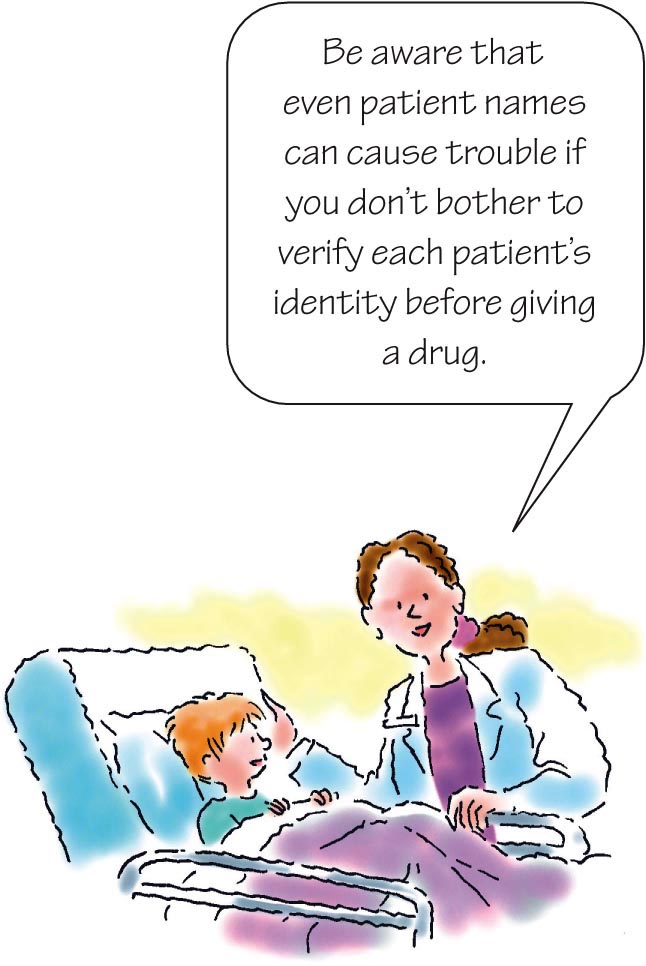
Drug names aren't the only names subject to confusion. Sometimes, patient names can cause trouble as well, especially when nurses don't verify each patient's identity before administering medications. Caring for two patients with the same or similar first or last name can further complicate matters. Consider the following scenario.
A tale of two Bobs
Five-year-old Robert Brewer is hospitalized with measles. Robert Brinson, also age 5, is admitted to the same pediatric unit after a severe asthma attack. The boys are assigned to adjacent rooms. Each has a nonproductive cough.
The nurse caring for Robert Brewer enters his room to give him an expectorant. As the nurse is about to administer the drug, the child's mother informs her that someone else came into the room a few minutes ago to give Robert a medication that he inhaled by mask. The nurse quickly determines that another nurse mistakenly gave Robert Brinson's medication (acetylcysteine—a mucolytic) to Robert Brewer.
Fortunately, no harmful adverse effects developed. However, if the other nurse had checked the patient's identity more carefully, this error would never have occurred.
Check and double-check
Always verify the patient's identity using two patient identifiers. The two identifiers may be included in the same location, such as the hospital identification bracelet. Acceptable identifiers include the patient's first and last names, assigned identification number (such as the medical record number), and birth date. Involve the patient and /or family in the identification process by asking for the full name and birthdate.
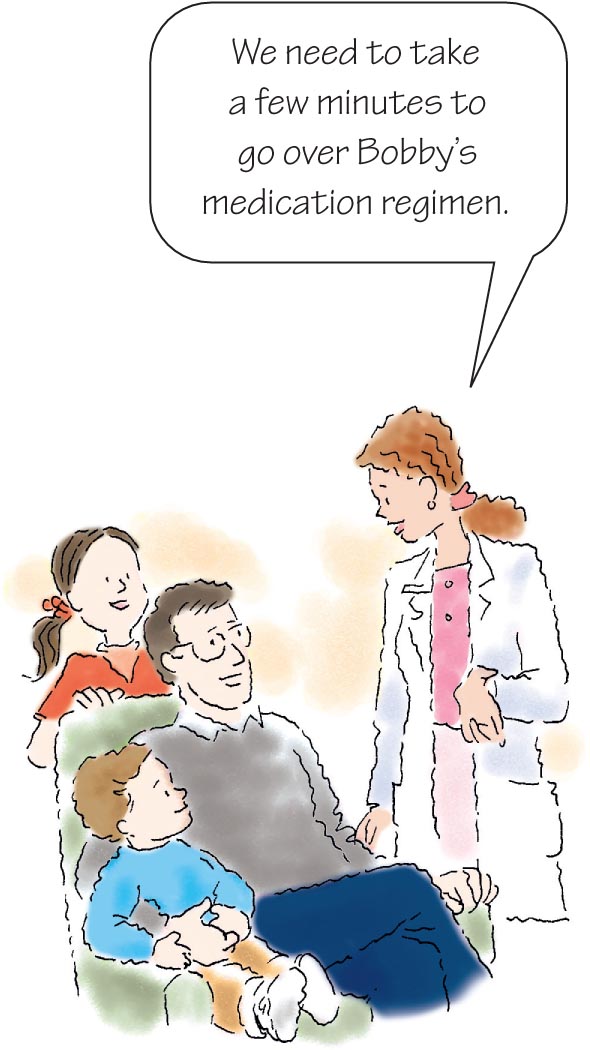
Teach the patient (or parents if the patient is a child) to offer his identification bracelet for inspection when anyone—including the nurse, doctor, advanced practice registered nurse, anesthetist, or respiratory therapist—enters his room to administer a medication. Also urge patients to tell you or another nurse whenever an identification bracelet falls off, is removed, or becomes misplaced. Then, replace it or substitute a new one immediately. (See Raising the bar with bar coding.)
Patients can also be taught what their medications look like, how they're given, and at what times they should take them. That way, they know what they should be receiving while in the hospital and are prepared to safely use the drug after discharge. Medication administration should be interactive, involving the patient and family in the process. (See Preventing drug errors through teaching.)
After you've verified your patient's identity, check to see if he's wearing allergy identification, such as MedicAlert jewelry. All allergy identification tags or jewelry should have the name of the specific allergen conspicuously written or embossed on them. This same allergy information should be recorded on the front of the patient's chart and on his medication record. Patients admitted to the hospital must wear a band that identifies the patient has an allergy but will not state the allergy on the band . You will have to refer to the chart to review the allergy list and reaction to all allergies. Most electronic medical records show the allergy across the top of the header. Regardless of whether the patient is wearing allergy identification, take the time to ask the patient directly about drug allergies—even if he's in distress. Sometimes patients forget to add an allergy to their list at the PCP's office, and some patients don't regularly see doctors. Asking the patient directly is sometimes your only safeguard against this type of error.

A distressing situation
Consider this example. The doctor issues a stat order for lorazepam (Ativan) for a distressed patient. By the time the nurse arrives with the drug, the patient has grown more visibly distressed. Unnerved by the patient's demeanor, the nurse quickly administers the drug—without verifying the patient's identity and checking the patient's allergy bracelet or medication administration record first, and without documenting the order. The patient has an immediate allergic reaction.
Because the patient's allergy bracelet clearly stated his known allergy, and this same information was clearly indicated on his chart and medication administration record, this error was fully preventable.
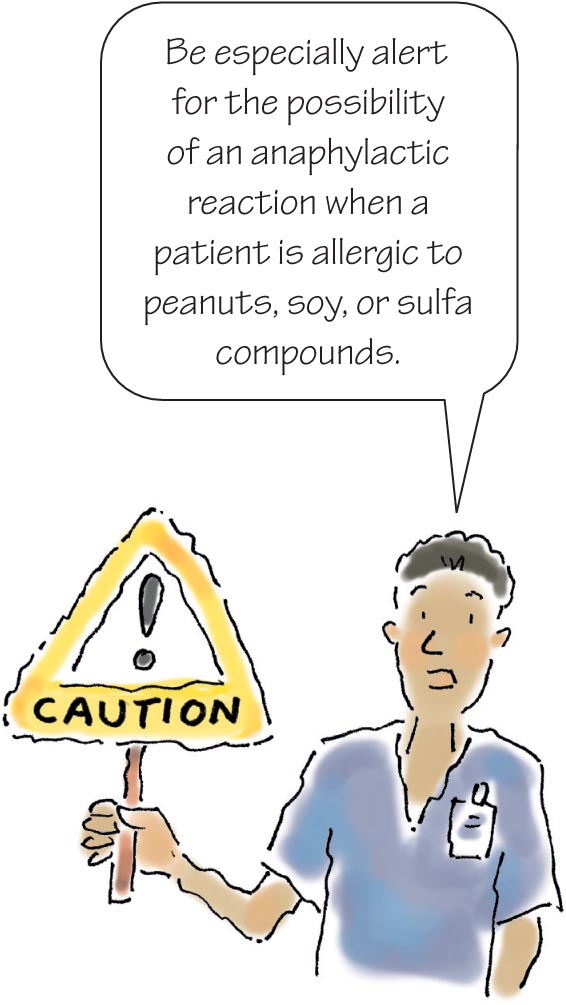
Resisting temptation
Any time you're in a tense situation with a patient who needs or wants medication fast, resist the temptation to act first and document later. Skipping this crucial step can easily lead to a medication error.
Not just talking peanuts
Certain medications should never be given to patients allergic to peanuts, soy, or sulfa compounds. Keep these tips in mind to help prevent allergic reactions in these patients:
A patient who's severely allergic to peanuts or soy may have an anaphylactic reaction (a severe, life-threatening reaction) to ipra-tropium (Atrovent) aerosol given by metered-dose inhaler. Ask the patient (or parents) whether he's allergic to peanuts or soy before giving this drug. If you find that he has such an allergy, you'll need to use the nasal spray or inhalation solution (nebulizer) form of the drug. Because neither form contains soy lecithin (an emulsifier used in the metered-dose formula), it's safe for patients allergic to peanuts or soy.
Patients allergic to sulfa drugs shouldn't receive sulfonylurea antidiabetic agents, such as chlorpropamide (Diabinese), glyburide (Micronase), and glipizide (Glucotrol).
For a drug to be given correctly, each member of the healthcare team must fulfill an appropriate role: The prescriber must choose the right medication for the patient, then write the order correctly and legibly or enter it into the computer correctly. Most electronic systems offer the correct choices for the provider to choose from. The pharmacist must interpret the order, determine whether it's complete and safe, and prepare the drug using precise measurements. Finally, the nurse must evaluate whether the medication is appropriate for the patient, ensure the correct patient and time, and then administer the medication correctly according to facility guidelines.

Never break the chain
A breakdown along this chain of events can easily lead to a medication error, an error that's further compounded because of the number of people who could have prevented it. That's why it's vital for all healthcare providers to work together as a team, supporting and helping each other to promote the best patient care. In some cases, working as a team may be as simple as asking for further clarification or as complicated as double-checking another practitioner's action and calling him to task.
Calling all pharmacists
For instance, the pharmacist can help clarify the number of times a drug must be given each day. He can also help you label drugs in the most appropriate way. Or, he can remind you to always return unused or discontinued medications to the pharmacy. Pharmacists also check into allergies, like not dispensing sulfa-containing antibiotics to patients allergic to sulfa.
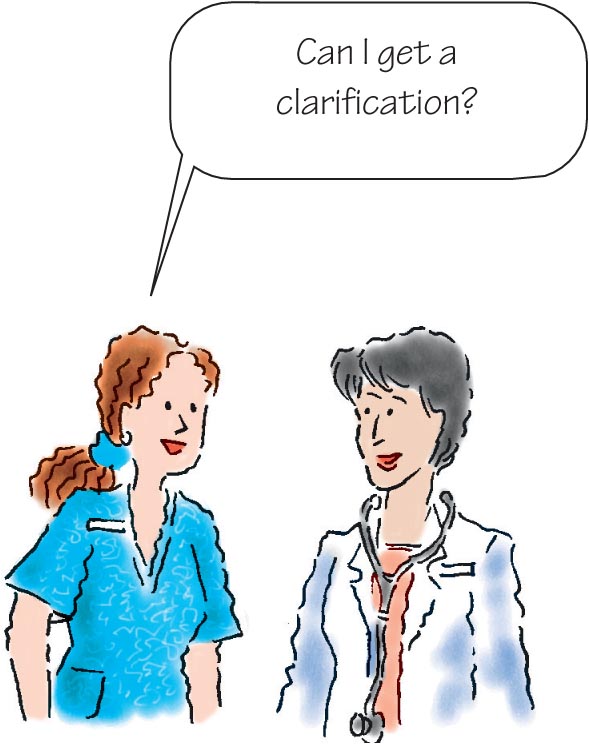
I can see clearly now
As a nurse, you're responsible for clarifying a prescriber's order that doesn't seem clear or correct. You must also correctly hand le and store multidose vials obtained from the pharmacist, and administer only those drugs that you've personally prepared. Multidose vials must always be labeled. Never give a drug with an ambiguous label or no label at all. Here's an example of what could happen if you do.
A shocking mistake
The nurse places an unlabeled syringe on a tray near a patient in the operating room. The nurse gets called away unexpectedly and the doctor administers the medication. The doctor thought the syringe contained bupivacaine (Marcaine), but instead it contained 30 mL of epinephrine 1:1,000, which the nurse had drawn up into the syringe. The patient developed ventricular fibrillation, was immediately defibrillated, and then needed to be transferred to the intensive care unit, where he later recovered.
Obviously, this was a compound medication error. The nurse should have labeled the syringe clearly, and the doctor should never have given an unlabeled drug to the patient.
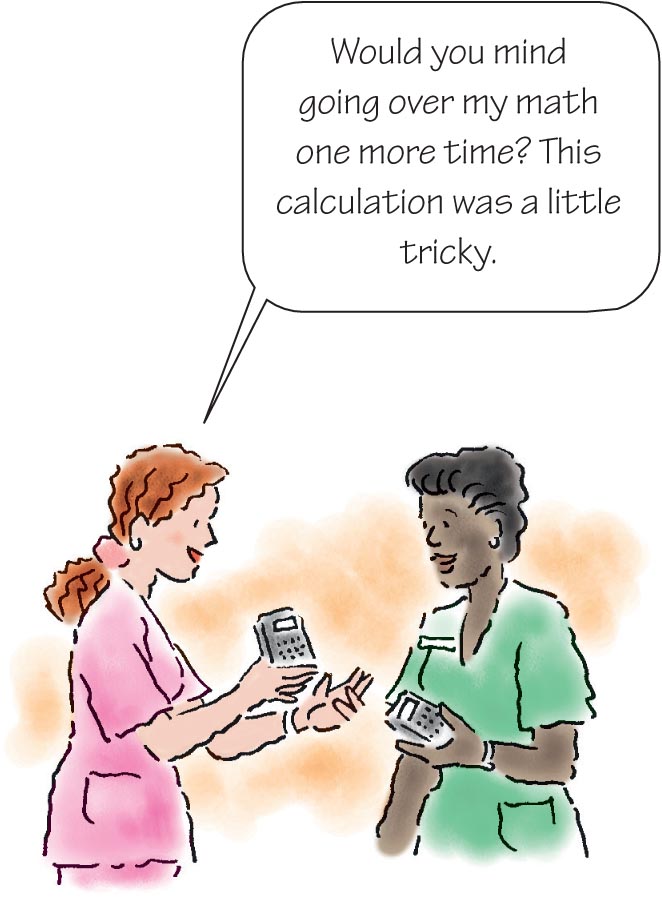
Liters vs. grams
In another example of a compound error, a nurse working in the neonatal intensive care unit prepares a dose of aminophylline to administer to an infant. No one bothers to check the nurse's calculations. Shortly after receiving the drug, the infant develops tachycardia and other signs of theophylline toxicity and later dies. The nurse thought that the order read 7.4 mL of aminophylline. Instead, it read 7.4 mg.
This tragedy might have been avoided if the doctor had written a clearer order, if the nurse had clarified the order before administering it, if the pharmacist had prepared and dispensed the drug, or if another nurse had double-checked the dosage calculation. To avoid this type of problem, many facilities require pharmacists to prepare and dispense all nonemergency parenteral doses whenever commercial unit doses aren't available.
Take necessary precautions to breathe easier
Here's another example: A nurse mistakenly leaves a container of 5% acetic acid (used to clean tracheostomy tubing) near nebulization equipment in the room of a 10-month-old infant. A respiratory therapist mistakes the liquid for normal saline solution and uses it to dilute albuterol for the child's nebulizer treatment. During the treatment, the child experiences bronchospasm, hypercapnic dyspnea, tachypnea, and tachycardia.
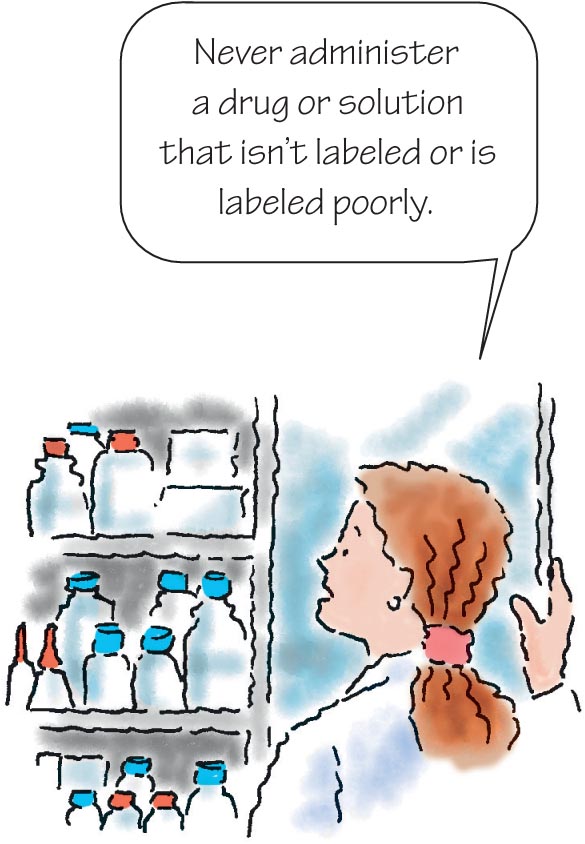
Leaving dangerous chemicals near patient-care areas is extremely risky. Never leave medications at the patient's bedside. Return them to the locked medication room to be stored. All medications must be labeled with the patient information, drug name, and strength.
Many drug errors stem, at least in part, from problems involving the route of administration. The risk of error increases when a patient has several lines running for different purposes, as illustrated in the following scenario.
Crossing the line
A nurse prepares a dose of digoxin elixir for a patient with a central IV line and a jejunostomy tube in place. She mistakenly administers the oral drug into the central IV line. Fortunately, the patient suffers no adverse effects.
To help prevent similar mix-ups in the route of administration, prepare all oral medications in a syringe that has a tip small enough to fit an abdominal tube but too large to fit a central line. Some facilities even use designated tubing for enteral feedings, so that it can't be inadvertently connected to an IV line. When preparing all medications that will be administered by syringe, label the syringe in the medication room with the patient name, drug, and route. This will help ensure that if a distraction occurs on the way to the patient room, you as the nurse will not administer the drug to the wrong patient or via the wrong route.

Clearing the air
Here's another error that could have been avoided: To clear air bubbles from a 9-year-old patient's insulin infusion, the nurse disconnects the tubing and raises the pump rate to 200 mL/hour, flushing the bubbles through quickly. She then reconnects the tubing and restarts the infusion, but she forgets to reset the drip rate back to 2 units/hour. The child receives 50 units of insulin before the nurse detects the error.
To prevent this kind of mistake, never increase the drip rate to clear bubbles from a line. Instead, remove the tubing from the pump, disconnect it from the patient, and use the flow-control clamp to establish gravity flow of the IV fluid to purge the air from the line.
High-alert medications and the independent double-check
The Joint Commission and each facility have identified medications that are considered high-alert and may require an independent double-check prior to administration to the patient. Examples of these medications are antidiabetic agents, narcotics, anticoagulants, and chemotherapy drugs. The independent double-check consists of two nurses reviewing the order and each nurse, independent of each other, calculating the amount and how the drug should be given. They both compare their findings to confirm accuracy prior to giving to the patient. This is mand atory. It ensures patient safety and is vital in preventing medication errors.
Smart pumps for the administration of IV medications help to reduce the risk of infusion errors. Many have stand ardized medication concentration libraries to choose the correct concentration of the medication. They also contain guardrail alarm limits to control the flow rate ranges for which certain medications can be set, further helping to reduce errors.
Some commonly used abbreviations are known to contribute significantly to drug errors. For example, in a doctor's order reading levothyroxine (Synthroid) 50 µg PO daily, the µg (meaning micrograms) may be easily misinterpreted to mean milligrams. The patient could mistakenly receive 50 mg of levothyroxine, or 1,000 times the ordered dose.
The Joint Commission guidelines
To prevent such devastating errors, every facility should make a “Do not use” list readily available for all healthcare workers. This list identifies abbreviations that should never be used in any form, under any circumstances. In fact, The Joint Commission has compiled a list of dangerous abbreviations that should be avoided in all clinical documentation, including doctor's orders, patient charts, progress notes, consultation reports, operative reports, educational materials, and protocols and pathways. The use of electronic medical records helps to correct these transcription errors. The nurse must still remain diligent when preparing and administering medications. (See The Joint Commission's Do not use list.)
Shorthand for shortsighted
Abbreviating or using a shorthand version of a drug name is equally risky, as shown in this example: Epoetin alfa (Epogen), a synthetic form of erythropoietin that's commonly abbreviated as EPO, is occasionally used by anemic cancer patients to stimulate red blood cell production. In one case, a doctor wrote, “May take own supply of EPO” on the discharge orders of a patient whose cancer was in remission. However, the patient wasn't anemic.
Sensing that something was wrong with ordering epoetin alfa for a patient who isn't anemic, the pharmacist interviewed the patient, who confirmed that he was taking “EPO,” or evening primrose oil, to lower his cholesterol level. Fortunately, the pharmacist became aware of his misinterpretation of the abbreviation before an error could occur in this situation.
To avoid this type of error, ask prescribers to spell out all drug names.
As a rule of thumb, if you're unfamiliar with a drug that a doctor prescribes, always consult a drug reference before administering the medication to the patient. Also, ask the prescriber to clarify vague or ambiguous terms. Don't assume that you'll get it right on your own.
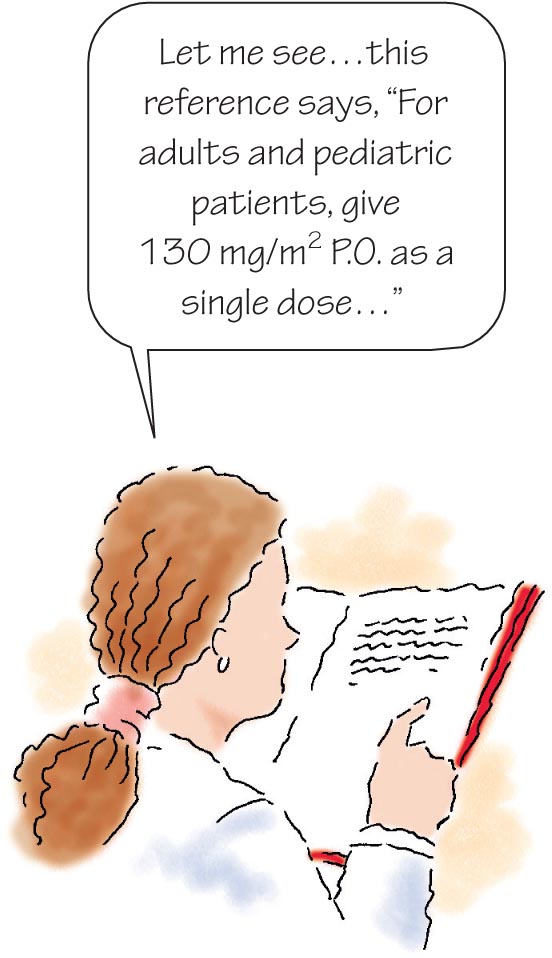
Guessing is always wrong
Here's an example. A patient was supposed to receive one dose of the antineoplastic drug lomustine (Ceena) to treat brain cancer. (Lomustine is typically given as a single oral dose once every 6 weeks.) The doctor's order read, “Administer at night.” Because the evening shift nurse misinterpreted the order to mean “every night” when the doctor meant “at bedtime,” the patient received three daily doses of a drug he should have only received once, developed severe thrombocytopenia and leukopenia, and then died.
Remember to clarify confusing orders with the prescriber and to read each order carefully. Keep a drug reference book hand y at all times. It's important to look up any drugs you're unfamiliar with—doing so may prevent an error and save a life.
Did I hear you right?
In rare cases, you may need to follow a doctor's verbal order to administer a drug. These situations typically involve when the physician is scrubbed for a sterile procedure or emergencies, such as resuscitation of a patient, when there's no time to write out an order. If you find yourself in this type of situation, follow these incredibly easy but vital steps: be sure to listen closely to the instruction, repeat it back to the doctor to ensure you've heard him correctly, hear the doctor confirm you are correct before administering the drug if possible, then promptly document the order and the details of the incident in the patient's chart when you are able. Make sure that the doctor reviews and signs all orders as necessary as soon as the patient has stabilized. Remember to always document that you read back the order to the physician for clarification.

It's extremely important to know your facility's policy on accepting and documenting verbal orders. Be aware that many facilities have started phasing out verbal orders and telephone orders because of the prevalence of computers at nurse's stations and throughout key departments on every floor, allowing medical orders to be entered and retrieved quickly from virtually any location. With the increase in electronic orders, providers are not able to enter the orders even while away from the health setting.
Sometimes, the incorrect selection of a drug compound or solution strength when preparing a medication can be harmful, even fatal, to the patient. With practice, nurses can develop a sharp eye for this type of error, as illustrated in the following situations. In both cases, the alert nurses noticed that antineoplastics prepared in the pharmacy appeared suspiciously different and took the appropriate action.
The sleuthing Holmes…
The first case involves a 6-year-old child who was to receive 12 mg of methotrexate intrathecally. The pharmacist hand ling the order mistakenly selected a 1-g vial of methotrexate instead of a 20-mg vial and reconstituted the drug with 10 mL of normal saline solution. The preparation containing 100 mg/mL was incorrectly labeled as containing 2 mg/mL, and 6 mL of the solution was drawn into a syringe. Although the syringe label indicated 12 mg of methotrexate, the syringe actually contained 600 mg of the drug.
The nurse who received the syringe observed that the drug's color didn't appear correct, and she returned it to the pharmacy for verification. The pharmacist retrieved the vial he had used to prepare the dose and withdrew the remaining solution into another syringe. He compared the solutions in both syringes and , noting that they matched, concluded that the color change was due to a change in the manufacturer's formula. No one noticed the vial's 1-g label.
The child received the 600-mg dose and experienced seizures 45 minutes later. A pharmacist responding to the emergency detected the error. The child received an appropriate antidote and soon recovered.
…and Dr. Watson
In a similar case, a 20-year-old patient with leukemia was supposed to receive mitomycin (Mitozytrex) instead of mitoxantrone (Novantrone). These drugs are both antineoplastic antibiotics; however, mitoxantrone is a dark blue liquid.
Upon receiving the medication from the pharmacy, the nurse noticed the unusual bluish tint of what was labeled mitomycin and immediately questioned the pharmacist. The pharmacist assured her that the color difference was due to a change in manufacturer, and so she administered the drug. Upon further investigation, however, it was discovered that the pharmacist had mislabeled a solution of mitoxantrone as mitomycin. Fortunately, the patient suffered no harmful effects.
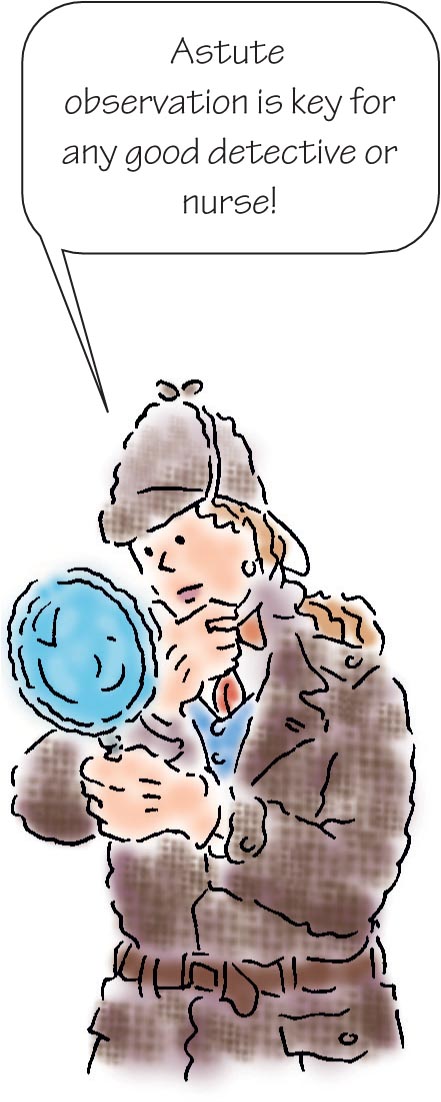
It's elementary!
If a familiar drug seems to have an unfamiliar appearance, investigate the cause. If the pharmacist cites a manufacturing change, ask him to double-check whether he's received verification from the manufacturer. Always document the appearance discrepancy, your actions, and the pharmacist's response in the patient record.
Medication errors can occur when communication about medications isn't clear as patients move from one healthcare setting to another. To prevent this type of error, it's important to obtain, maintain, and communicate an accurate list of the patient's medications whenever new medications are ordered or medication dosages are changed. Some facilities require two registered nurses to reconcile new drug orders by having a chart check due every 12 hours or requiring two nurse signatures with new admissions.
List and compare
Whenever a patient is admitted to your facility, create a list of all his current medications. Involve the patient and his family to make sure that the list is accurate and complete. Then use this list to compare the medications he was receiving at home to those ordered in your facility, to reconcile any discrepancies. It is the responsibility of the nurse to gather the information and the responsibility of the physician to reconcile the medications.
The big hand -off
If the patient is transferred to other areas within your facility, communicate the current list of medications to the next care team and document that communication took place in the patient's medical record. Likewise, if the patient is transferred to another healthcare facility, provide a complete reconciled list to the receiving facility and document in the patient's medical record that communication took place.
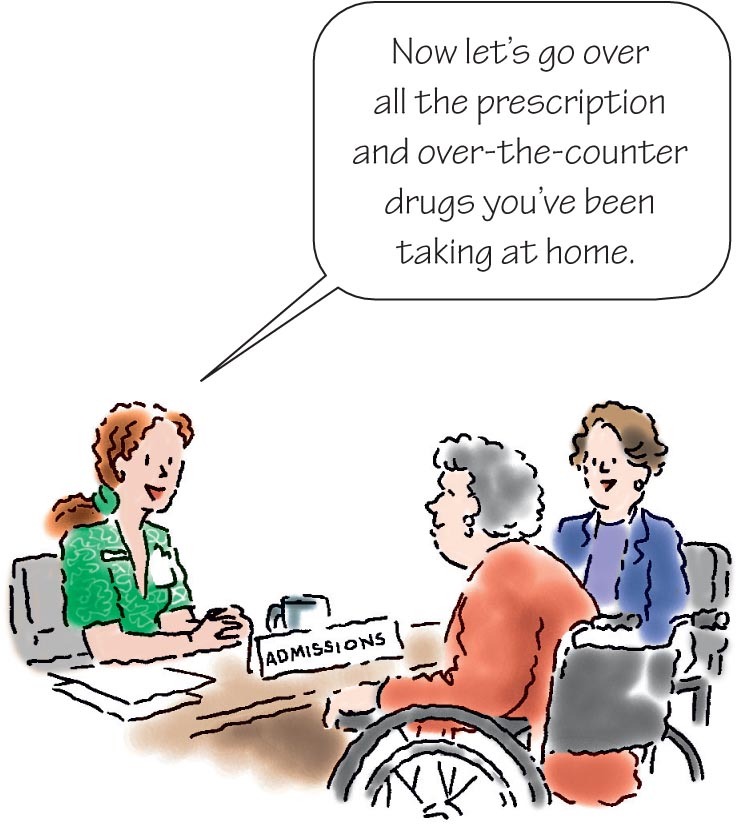
Can I have that to go?
When a patient is discharged home, give the complete reconciled list of medications to the patient and his family if approval is given. Take time to explain the list so that they understand the medications and any possible adverse reactions. The reconciled list should also be sent to the patient's primary doctor or next known health-care provider.
A day of reckoning
Here's an example of what can go wrong when a patient's medication list isn't reconciled. When a 56-year-old man was admitted to the cardiac intensive care unit with acute myocardial infarction, he was prescribed nitroglycerin, morphine, metoprolol, aspirin, oxygen, and betaxolol (to treat his glaucoma). Within 2 days, the patient's condition improved and he was transferred to the cardiac step-down unit, where his medication regimen included nitroglycerin, morphine, metoprolol, aspirin, and oxygen, as needed. The following morning, the patient asked the nurse why he hadn't received his eye drops. Had the medication list been reconciled on admission to the step-down unit, this error could have been prevented.
No one will argue that nursing is sometimes a difficult, stressful occupation, even under the best circumstances. Clearly, nurses carry a great deal of responsibility in drug administration, ensuring that the right patient gets the right drug, in the right concentration, at the right time, and by the right route. Interruptions can cause stress and errors when preparing medications. Take time in the medication room or a quiet area to review the medication order and review your rights for the medications prior to your interaction with the patient.
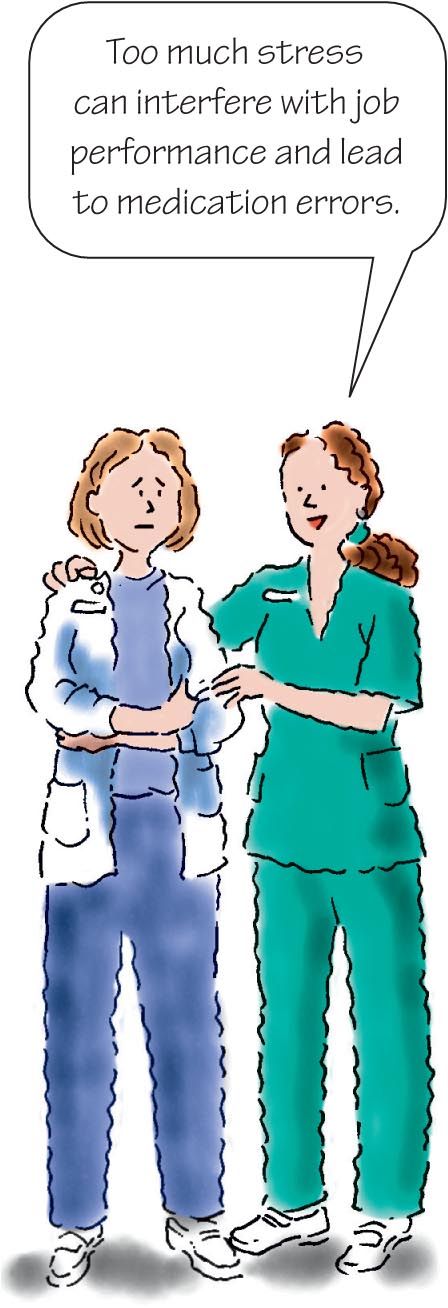
Recognizing stressors
Too much stress—whether personal, job-related, or environmental—can cause or contribute to drug errors. You should attempt to avoid stress, or at least learn to recognize and minimize it. This will help lower your risk of making errors and maximize the therapeutic effects of your patients' drug regimen.
Added stress from error
Committing a serious medication error can cause enormous stress that might cloud your judgment. If you're administering a medication and realize that you've made a mistake, seek help immediately instead of trying to remedy the situation yourself, as in the following situation.
A nurse–anesthetist just gave the sedative midazolam to the wrong patient. Discovering her error, she reaches for what she thinks is a vial of the antidote, flumazenil (Romazicon), then withdraws 2.5 mL of the drug and administers it to the patient. When the patient fails to respond, the nurse–anesthetist realizes that she must have inadvertently reached for a vial of ondansetron (Zofran), an antiemetic. She quickly calls for another practitioner, who assists with proper IV administration of flumazenil. The patient recovers unharmed.